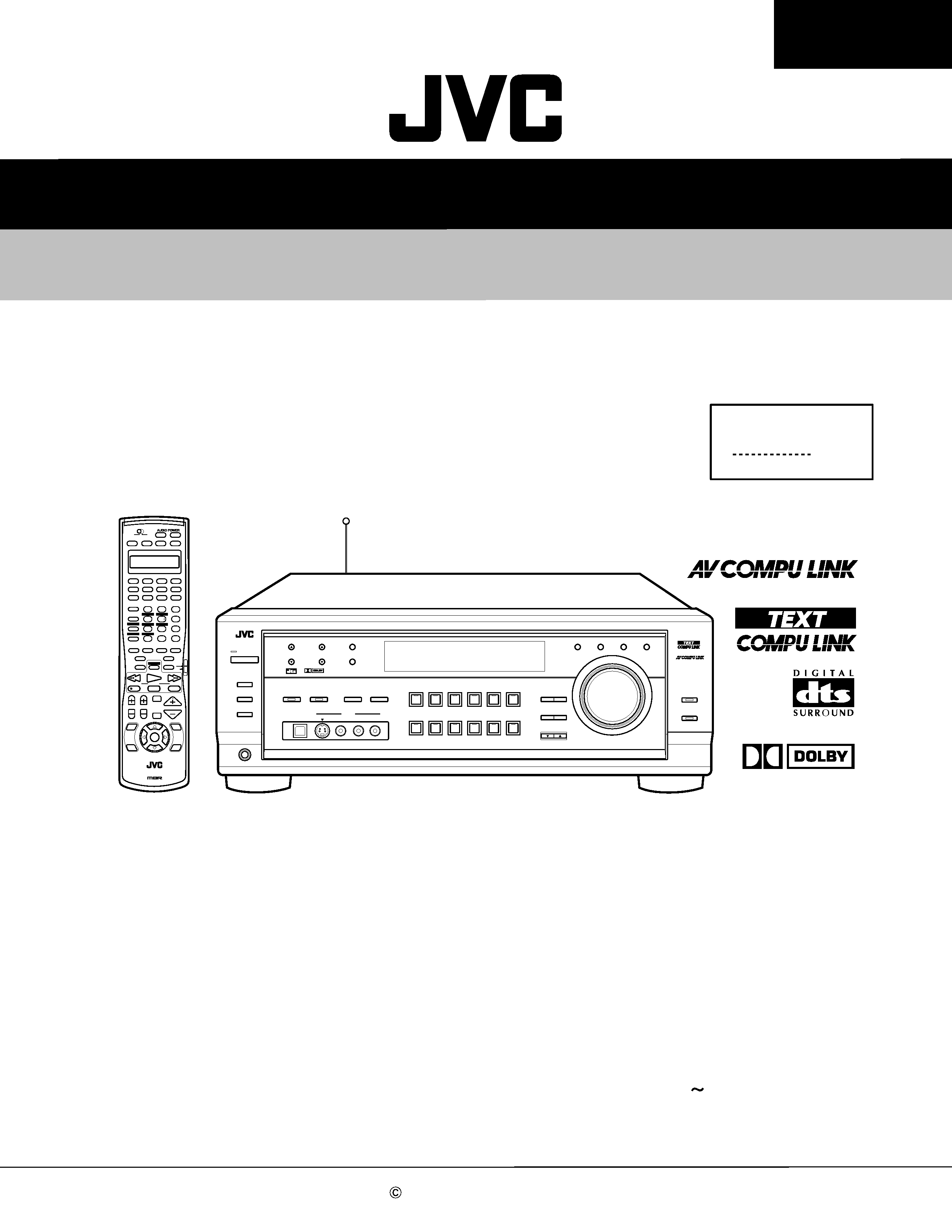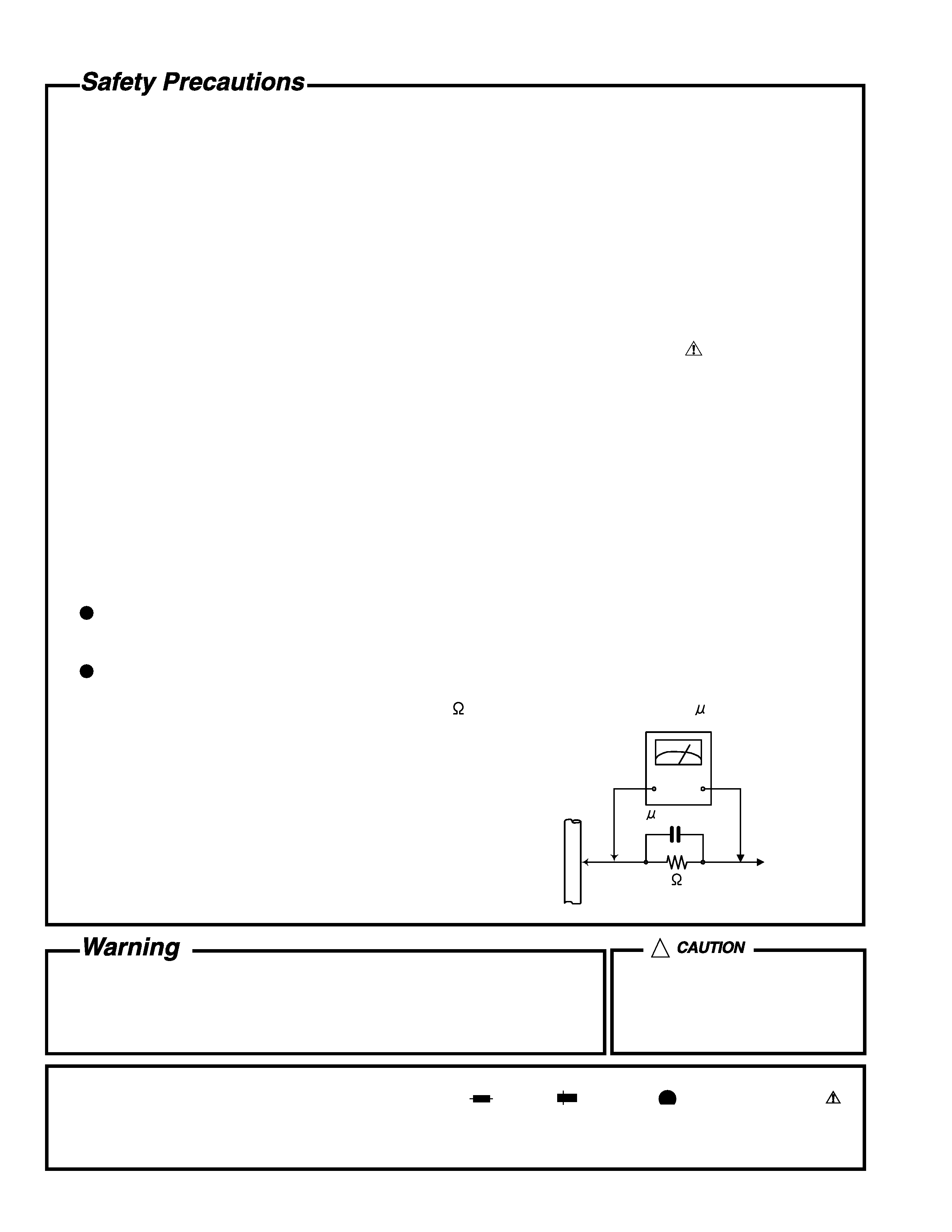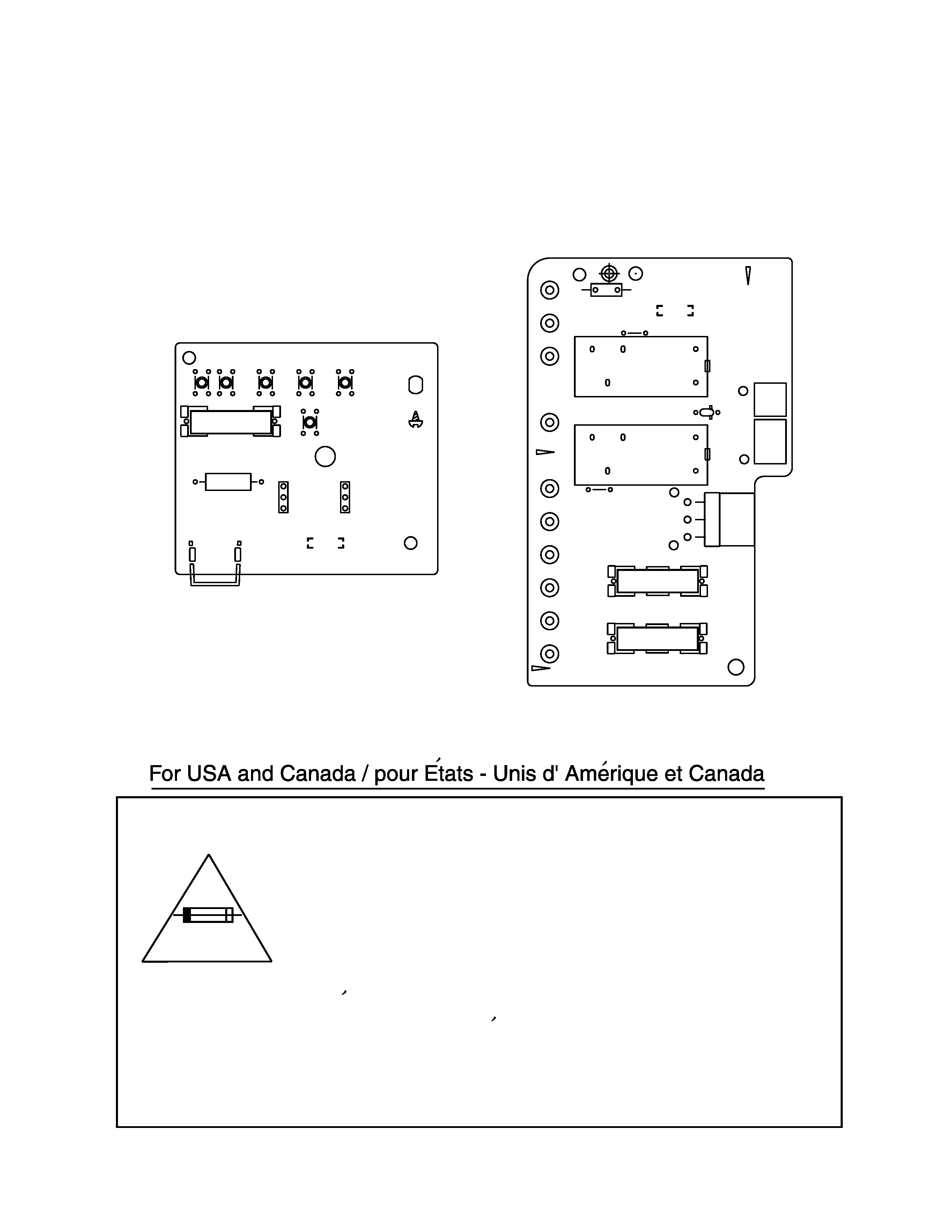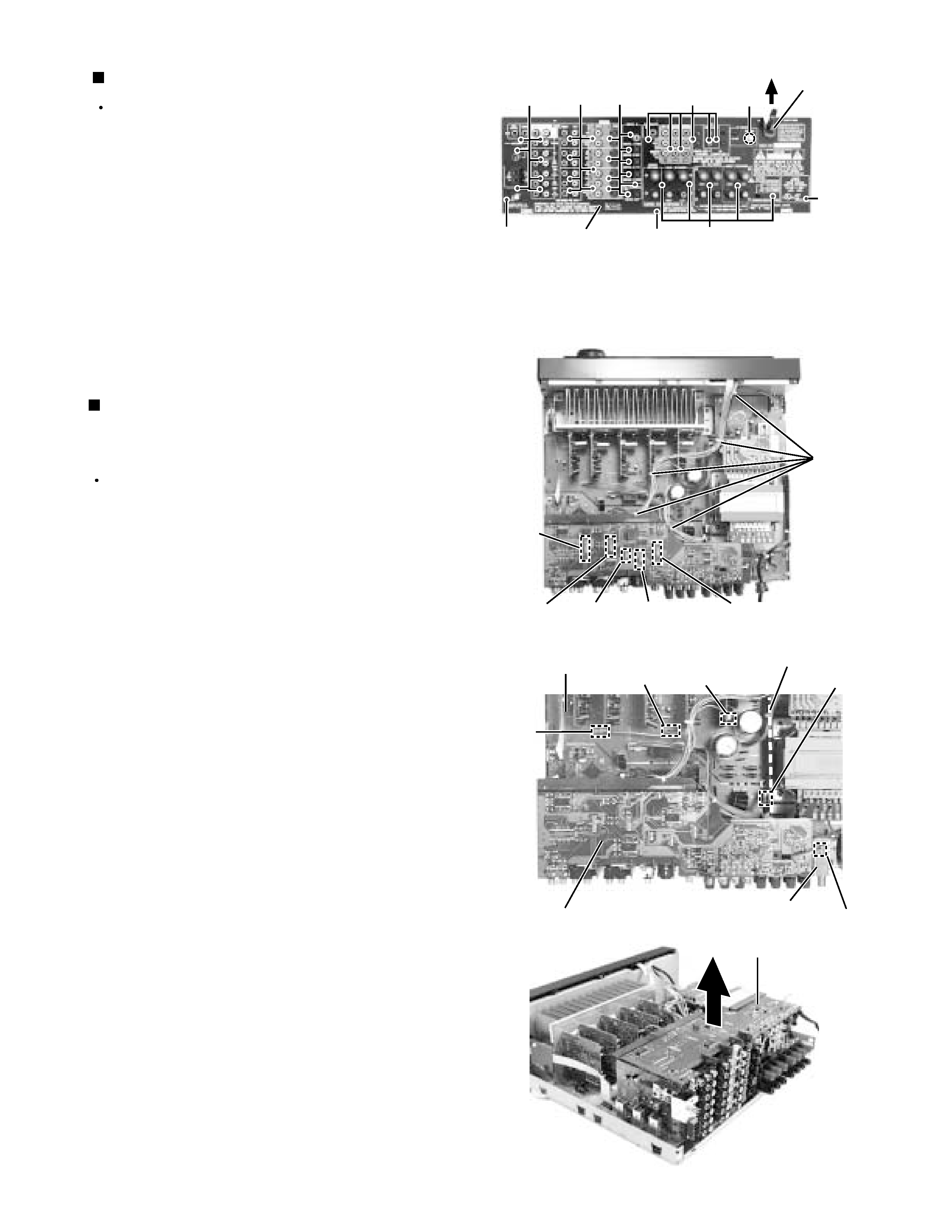
SERVICE MANUAL
AUDIO/VIDEO CONTROL RECEIVER
No.20940
Apr. 2001
COPYRIGHT
2001 VICTOR COMPANY OF JAPAN, LTD.
RX-9010VBK
RX-9010VBK
J
U.S.A.
Area Suffix
Contents
Safety precautions --------------------------------------------------------1-2
Importance administering point on the safety --------------------- 1-3
Disassembly method -----------------------------------------------------1-4
Adjustment method -------------------------------------------------------1-10
Self-diagnose function ----------------------------------------------------1-11
Description of major ICs -------------------------------------------------1-13 30
DIGITAL
CONTROL
DOWN
UP
EFFECT SETTING
DIGITAL
EQ
TV SOUND/DBS
VIDEO
VCR 2
VCR 1
DVD
DVD MULTI
MIDNIGHT MODE
DSP MODE
S-VIDEO
VIDEO
VIDEO
L--AUDIO--R
SURROUND ON/OFF
SUBWOOFER OUT ON/OFF
SPEAKERS ON/OFF
FM/AM TUNING
FM/AM PRESET
FM MODE
MAIN ROOM ON/OFF
SUB ROOM ON/OFF
SUB ROOM CONTROL
DIMMER
MEMORY
2
PHONES
STANDBY
POWER
USB AUDIO
INPUT
ANALOG/DIGITAL
INPUT ATT
FM / AM
USB AUDIO
TAPE / MD
CDR
CD
PHONO
LEVEL
ADJUST
RX-9010V
AUDIO/VIDEO CONTROL RECEIVER
LINE DIRECT
BASS BOOST
MASTER VOLUME
DIGITAL
SURROUND
DIGITAL
1
SOURCE NAME
SOURCE NAME
MAIN ROOM
SUB ROOM
CHANNEL
TV/VIDEO
MUTING
DVD
ON/OFF
ON/OFF
POWER
POWER
STANDBY
TV/CATV/DBS
VCR1
ON
DVDMULTI
CD
CDR
PHONO
TAPE/MD
USB AUDIO
ANALOG/DIGITAL
L--BALANCE--R
EFFECT
ROOM SIZE
SOUND
TEST
LINE DIRECT
MIDNIGHT MODE
SLEEP
DIMMER
FM MODE
DSP
BASS BOOST
SURROUND
RETURN
100+
ON/OFF
MODE
CENTER TONE
INPUT
LIVENESS
SET
MENU
DVD
MENU
EXIT
TEXT
DISPLAY
123
456
789
10
+
10
0
TV VOL
VOLUME
TUNING
STOP
PAUSE
FF/
/REW
REC
PLAY
DOWN
UP
RM-SRX9010J
REMOTE CONTROL
A/V CONTROL RECEIVER
VCR 1
VCR 2
FM/AM
VIDEO
TV/DBS
SUB ROOM
MAIN ROOM
SUB ROOM
MAIN ROOM
CONTROL
TV
CATV/
DBS
CENTER
SUBWFR
LEVEL+
LEVEL
REAR·L
DIGITAL EQ
REAR·R

RX-9010VBK
1-2
1. This design of this product contains special hardware and many circuits and components specially for safety
purposes. For continued protection, no changes should be made to the original design unless authorized in
writing by the manufacturer. Replacement parts must be identical to those used in the original circuits. Services
should be performed by qualified personnel only.
2. Alterations of the design or circuitry of the product should not be made. Any design alterations of the product
should not be made. Any design alterations or additions will void the manufacturer`s warranty and will further
relieve the manufacture of responsibility for personal injury or property damage resulting therefrom.
3. Many electrical and mechanical parts in the products have special safety-related characteristics. These
characteristics are often not evident from visual inspection nor can the protection afforded by them necessarily
be obtained by using replacement components rated for higher voltage, wattage, etc. Replacement parts which
have these special safety characteristics are identified in the Parts List of Service Manual. Electrical
components having such features are identified by shading on the schematics and by (
) on the Parts List in
the Service Manual. The use of a substitute replacement which does not have the same safety characteristics
as the recommended replacement parts shown in the Parts List of Service Manual may create shock, fire, or
other hazards.
4. The leads in the products are routed and dressed with ties, clamps, tubings, barriers and the like to be
separated from live parts, high temperature parts, moving parts and/or sharp edges for the prevention of
electric shock and fire hazard. When service is required, the original lead routing and dress should be
observed, and it should be confirmed that they have been returned to normal, after re-assembling.
5. Leakage currnet check (Electrical shock hazard testing)
After re-assembling the product, always perform an isolation check on the exposed metal parts of the product
(antenna terminals, knobs, metal cabinet, screw heads, headphone jack, control shafts, etc.) to be sure the
product is safe to operate without danger of electrical shock.
Do not use a line isolation transformer during this check.
Plug the AC line cord directly into the AC outlet. Using a "Leakage Current Tester", measure the leakage
current from each exposed metal parts of the cabinet, particularly any exposed metal part having a return
path to the chassis, to a known good earth ground. Any leakage current must not exceed 0.5mA AC (r.m.s.).
Alternate check method
Plug the AC line cord directly into the AC outlet. Use an AC voltmeter having, 1,000 ohms per volt or more
sensitivity in the following manner. Connect a 1,500
10W resistor paralleled by a 0.15 F AC-type capacitor
between an exposed metal part and a known good earth ground.
Measure the AC voltage across the resistor with the AC
voltmeter.
Move the resistor connection to eachexposed metal part,
particularly any exposed metal part having a return path to
the chassis, and meausre the AC voltage across the resistor.
Now, reverse the plug in the AC outlet and repeat each
measurement. voltage measured Any must not exceed 0.75 V
AC (r.m.s.). This corresponds to 0.5 mA AC (r.m.s.).
1. This equipment has been designed and manufactured to meet international safety standards.
2. It is the legal responsibility of the repairer to ensure that these safety standards are maintained.
3. Repairs must be made in accordance with the relevant safety standards.
4. It is essential that safety critical components are replaced by approved parts.
5. If mains voltage selector is provided, check setting for local voltage.
Good earth ground
Place this
probe on
each exposed
metal part.
AC VOLTMETER
(Having 1000
ohms/volts,
or more sensitivity)
1500
10W
0.15 F AC TYPE
!
Burrs formed during molding may
be left over on some parts of the
chassis. Therefore, pay attention to
such burrs in the case of
preforming repair of this system.
In regard with component parts appearing on the silk-screen printed side (parts side) of the PWB diagrams, the
parts that are printed over with black such as the resistor (
), diode (
) and ICP (
) or identified by the " "
mark nearby are critical for safety.
When replacing them, be sure to use the parts of the same type and rating as specified by the manufacturer.
(Except the JC version)

RX-9010VBK
1-3
Caution: For continued protection against risk of
fire, replace only with same type 6.3A/125V for
F201, 2A/125V for F202 and F203. This symbol
specifies type of fast operating fuse.
Precaution: Pour eviter risques de feux, remplacez
le fusible de surete de F201 comme le meme type
que 6.3A/125V, et 2A/125V pour F202 et F203.
Ce sont des fusibles suretes qui functionnes rapide.
^
Importance administering point on the safety
LVA10222-A3
LVA10222-A6
EP1
FC1
FC2
PW17
PW18
PW19
PW20
PW26
PW30
R1
TA1
TA2
B3141
B3142
B3143
B3144
B3145
B3146
B3147
B3148
B3151
B3152
B3149
B3150
CN55
CN56
CN811
B3191
D67
FC61
FC62
FC63
FC64
R61
B3192
RY62
RY63
111
112
113
121
122
123
131
132
133
134
6.3A-125V
2A-125V
2A-125V

RX-9010VBK
1-4
Remove the four screws A attaching the top cover
on both sides of the body.
Remove the three screws B on the back of the body.
Remove the top cover from behind in the direction of
the arrow while pulling both sides outward.
1.
2.
3.
Disassembly method
Removing the top cover (See Fig.1)
Prior to performing the following procedure, remove
the top cover.
Disconnect the card wire from connector CN400 on
the audio board and CN402 on the power supply
board in the front panel assembly.
Cut off the tie band fixing the harness.
Remove the three screws C
attaching the front
panel assembly.
Remove the four screws D attaching the front panel
assembly on the bottom of the body. Detach the front
panel assembly toward the front.
Remove the screw a fixing a bonding ground.
1.
2.
3.
4.
5.
Removing the front panel assembly
(See Fig.2 to 4)
Fig.1
Fig.2
Fig.3
A 2
A 2
B
Top cover
C
Power
supply
board
Audio board
CN400
Main
board
Tie band
D
C
Front panel assembly
Front panel assembly
D
CN402
Fig.4
Front panel
assembly
Headphone jack
a

RX-9010VBK
1-5
Prior to performing the following procedure, remove
the top cover and the rear panel.
Cut off the tie band fixing the harness.
Disconnect the connect CN501, CN243, CN205,
CN381, CN361 on the DVD board.
Disconnect the harness from connector CN721,
CN722 and CN723 on the main board.
Disconnect the harness from connector CN1 on the
antenna unit and remove the antenna unit.
Disconnect the harness from connector CN491 on
the relay board.
Disconnect the tuner board and audio board from
connector CN101 and CN301 on the audio board.
Pull out the video audio board, video board, S-video
board.
Disconnect the DSP board from connector CN601 on
the audio board.
1.
2.
3.
4.
5.
6.
7.
8.
Removing each board connected to the
rear side of the audio board
(See Fig.6 to 12)
Prior to performing the following procedure, remove
the top cover.
Remove the power cord stopper from the rear panel
by moving it in the direction of the arrow.
Remove the thirty five screws E and a hexagon nut b
attaching the each boards to the rear panel on the
back of the body.
Remove the three screws F attaching the rear panel
on the back of the body.
1.
2.
3.
Removing the rear panel (See Fig.5)
Fig.6
Fig.7
Tie band
CN723
CN361
CN381
CN243
CN501
CN721
CN722
CN205
Fig.8
DVD board
CN1
Main board
Antenna unit
CN491
Relay board
Fig.5
E
FE
F
F
Cord stopper
Rear panel
E
EE
b
DVD board
